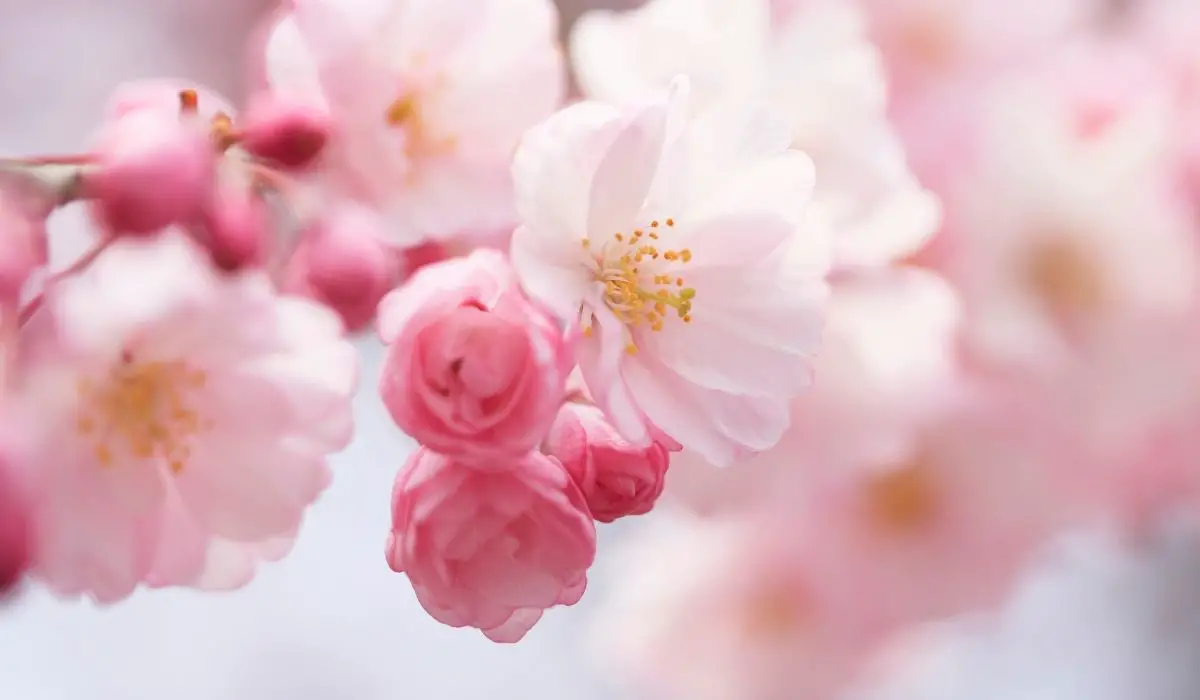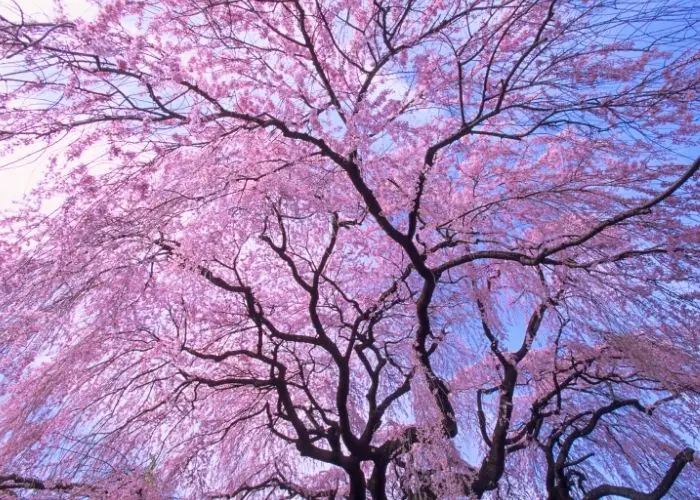Last Updated on May 29, 2022 by Cinthia
As a gardener, you need to know the right time to put fertilizer for the weeping cherry tree to provide it with the proper nutrients.
Whether you’re growing it for fresh snacks, baking pies, or just landscape interest, cherry trees are a fruitful endeavor, and every gardener can develop their own in their gardens.
There are so many reasons for growing cherry trees, and one of the biggest is picking your home-grown fruit, creating family memories, and preserving your harvest to enjoy during the winter months.
There are two types of cherry trees to grow – sweet cherries and sour cherries.
Two Types Of Cherries
Sweet Cherries
You commonly see these cherries at the supermarket. They have a meaty texture like the farm plan with Rich and sweet flavor and can be eaten fresh, cooked, or frozen. Cherry trees grow in USDA hardiness zones 5 to 7. Most of them are self-sterile and produce larger fruit from other sweet varieties in the area.
Sweet cherry trees take about 4 to 7 years after planting to bear fruit. This tree will yield about 15 to 20 quarts for dwarf trees and 30 to 50 quarts for semi-dwarf trees. The yield is determined by available nutrients, the soil quality, sunlight available, and local weather conditions during the season of the growth.
Sour Cherries
Also known as tart cherries, these cherries are primarily used in cooking, especially in baking pies, and are smaller than sweeter varieties. They thrive in USDA hardiness zones 4 to 6. They take about 3 to 5 years to begin bearing fruit, depending on the tree size, is a dwarf or semi-dwarf. The dwarf trees yield about 15 to 20 quarts, and semi-dwarf trees about 20 to 60 quarts. Like sweet cherry trees, the yield is based on the sunlight available, the soil quality, drainage of the available nutrients, and local weather conditions available during the growing season.
Fertilizing Cherry Trees
Fertilizing cherry trees is among the weeping cherry trees care that should be included. It is an excellent way to add nutrients to the soil, especially nitrogen. Nitrogen encourages green vegetation growth that is precisely what you want to promote before your cherry tree reaches its maturity level.
Before adding any fertilizers, always test your soils. Different soils can have varying amounts of nutrients needed to support cherry tree growth and development. When you discover your soil lacks any necessary nutrients like phosphates 4-0 nitrogen, be sure to choose a fertilizer that supplements its deficiency.
Fertilizer For Weeping Cherry Tree
Weeping cherry tree fertilizer can be either synthetic or organic fertilizers. It is possible to make your organic soil amendments like compost out of garden scraps foods. Alternatively, you can use organic soil amendments like compost or aged manual in compost manure and other organic soil amendments from a trusted local source. With this, you can add nutrients to the soil to support the growth of your cherry tree.
In general, macronutrients like nitrogen, potassium, and phosphorus should be present in the soil. Nitrogen helps to encourage the leaf’s growth; phosphorus encourages the root and blossom development, while potassium or potash is responsible for the tree’s disease resistance supporting its overall health.
These nutrients act like an immune system covering the tree with overall health. Water-soluble fertilizer is specifically formulated for young cherry trees providing the nutrients they need during their young years of development.
The weeping cherry tree is a light feeder and prefers a low-nitrogen fertilizer such as 5-10-10 or 10-15-15. Fertilize your weeping cherry tree at the right time, ensuring that you do not over-fertilize. Overfertilization produces an unbalanced tree that can affect its production, leaving it susceptible to pests and diseases.
Fertilizer For The Weeping Cherry Tree – Macronutrients
Nitrogen, phosphorus, and potassium are the big macronutrients cherry trees need to grow normally. They are present in healthy soil; you can add if the soil is deficient. Nitrogen is the essential nutrient playing a significant role in growing cherry trees. If your soil lacks nitrogen, you can add synthetic or organic compounds to provide it with the right amounts.
The primary source of nitrogen is decaying organic matter. Signs of nitrogen deficiency in cherry trees include pale or reddish-colored leaves, dead spots on leaves, and narrow or shrinking leaves.
Fertilizer For Weeping Cherry Tree – Micronutrients
Besides nitrogen, cherry trees also need micronutrients in the soil, which help make the macronutrients available for the tree. Micronutrients include copper and zinc that prevent color mottling clean and distorted leaves. Calcium is also a micronutrient that cherry trees love because it improves leaf and fruit quality. The easiest way to add micronutrients is by adding aged compost manure or a well-balanced fruit tree fertilizer with micronutrients such as part of the formula.
When Is The Right Time To Fertilize Cherry Trees?
If your soil is rich enough, you can withhold fertilizers until a cherry tree begins bearing fruit. This will be about 4 to 7 years for sweet cherries and 3 to 5 years for sour cherries. Consider fertilizing it starting the following spring if your new cherry tree does not put on several inches on new growth during the growing season.
Fertilizing cherry trees should be done once a year by applying a low-nitrogen fertilizer in a span of about 2 or 3 weeks before the tree blooms. You can still fertilize after the bud breaks; however, don’t let it go later than July. Always refer to the information and instructions printed on your product’s label for any specific fertilizer application. Remember that local advisories and fertilizer may be in effect during certain times of the year, and for the sake of your local environment, please adhere to the restrictions given.
Unlike other fruit trees, cherry trees do not require more nitrogen when they start bearing fruit. When growing this tree, ensure that you test your soil each year to see what it needs. If the nitrogen levels appear low, apply a low-nitrogen fertilizer in small amounts a couple of weeks before the bud breaks in early spring.
Be sure to mulch trees and keep weeds at bay because they will compete with your cherry tree trees for these nutrients.
Conclusion
Using fertilizer for your weeping cherry tree is an integral part of caring for your weeping cherry tree that every gardener should not skip.
Cherry trees are a beauty to behold on many farms. With the fabulous flowering display, they make the perfect focal point in any garden. The breathtaking leaf colors in the fall and striking bark colors warm the season and winter landscape.
Whenever you choose to grow weeping cherries in your yard, you are choosing to add a colorful appeal for the next many years to come.
Next up, find out all about The Ideal Brussel Sprouts Growing Season.
Caroline is a gardener who loves to get down to the nitty–gritty of gardening. She proudly proclaims herself as a ‘dirt worshipper‘ and can often be found deep in the garden, covered in soil and singing to her plants. As a self–proclaimed ‘plant whisperer‘, Caroline believes that plants need love and attention just like any other living thing, and she loves to give them both. When she‘s not tending to her garden, you can often find her researching the latest gardening trends, or teaching others how to make their gardens thrive




